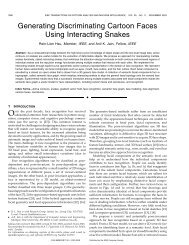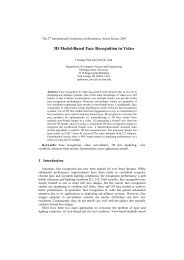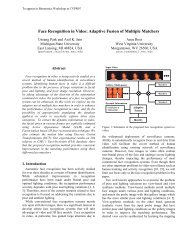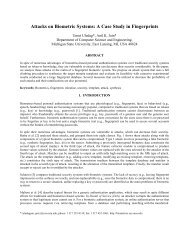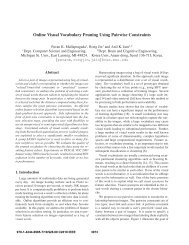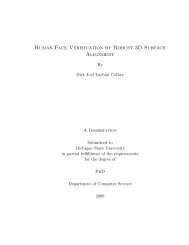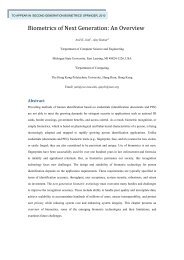Face Detection and Modeling for Recognition - Biometrics Research ...
Face Detection and Modeling for Recognition - Biometrics Research ...
Face Detection and Modeling for Recognition - Biometrics Research ...
Create successful ePaper yourself
Turn your PDF publications into a flip-book with our unique Google optimized e-Paper software.
verify the face present in an image in the recognition stage.<br />
This thesis has developed<br />
a robust face detection module which is used to facilitate applications such as face<br />
tracking <strong>for</strong> surveillance, <strong>and</strong> face modeling <strong>for</strong> identification (as well as verification).<br />
We will briefly discuss the topics of face detection <strong>and</strong> recognition, face modeling as<br />
well as compression, <strong>and</strong> face-based image retrieval in the following sections.<br />
1.4 <strong>Face</strong> <strong>Detection</strong> <strong>and</strong> <strong>Recognition</strong><br />
Human activity is a major concern in a wide variety of applications such as video<br />
surveillance, human computer interface, face recognition [37], [36], [38], <strong>and</strong> face<br />
image database management [40]. Detecting faces is a crucial step <strong>and</strong> usually the<br />
first one in these identification applications.<br />
However, due to various head poses,<br />
illumination conditions, occlusion, <strong>and</strong> distances between teh sensor <strong>and</strong> the subject<br />
(which may result in a blurred face), detecting human faces is an extremely difficult<br />
task under unconstrained environments (see images in Figs. 1.13 (a) <strong>and</strong> (b)). Most<br />
face recognition algorithms assume that the problem of face detection has been solved,<br />
that is, the face location is known. Similarly, face tracking algorithms (e.g., [61])<br />
often assume the initial face location is known. Since face detection can be viewed<br />
as a two-class (face vs. non-face) classification problem, some techniques developed<br />
<strong>for</strong> face recognition (e.g., holistic/template approaches [21], [62], [63], [64], featurebased<br />
approaches [65], <strong>and</strong> their combination [66]) have been used to detect faces.<br />
However, these detection techniques are computationally very dem<strong>and</strong>ing <strong>and</strong> cannot<br />
h<strong>and</strong>le large variations in faces. In addition to the face location, a face detection<br />
15



